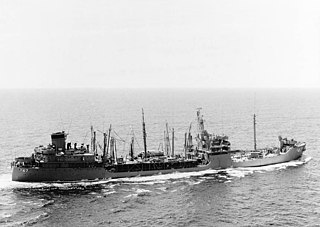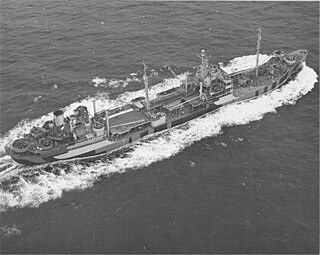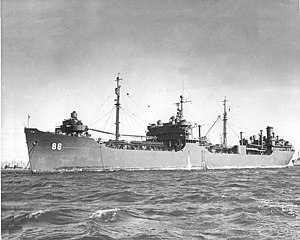
USS Hale (DD-642), a Fletcher-class destroyer, was the second ship of the United States Navy to be named for Maine Senator Eugene Hale (1836–1918).

USS Wilkes (DD-441) was a Gleaves-class destroyer commissioned in the United States Navy from 1941 to 1946. After spending several decades in the reserve fleet, the destroyer was scrapped in 1972.

USS Robinson (DD-562), a Fletcher-class destroyer, was the second ship of the United States Navy to be named for Captain Isaiah Robinson, who served in the Continental Navy.

USS Aulick (DD-569) was an American Fletcher-class destroyer, was the second ship of the United States Navy to be named for Commodore John H. Aulick (1787–1873).

USS Neches (AO-47) was a Kennebec-class oiler in the United States Navy during World War II and the Vietnam War. She was the second U.S. Navy ship named for the Neches River in eastern Texas.

USS Patuxent (AO-44) was a Kennebec-class oiler in the United States Navy during World War II. She was the second U.S. Navy ship named for the Patuxent River in Maryland.

USS Suamico (AO-49) was the lead ship of her class of Type T2-SE-A1 fleet oilers of the United States Navy.

USS Saugatuck (AO-75) was a Suamico-class replenishment oiler of the United States Navy.

USS Tallulah (AO-50), originally named the SS Valley Forge, was a Type T2-SE-A1 Suamico-class fleet oiler of the United States Navy.

USS Millicoma (AO-73) was a United States Navy fleet oiler which served in the Pacific Theatre during World War II, winning eight battle stars for her dangerous work. Post-war she was recommissioned and was placed under the control of the MSTS with a civilian crew until finally assigned for disposal in 1987.

USS Saranac (AO-74), originally named the SS Cowpens, was a Type T2-SE-A1 Suamico-class fleet oiler of the United States Navy, and the fourth ship of the Navy to bear the name.

USS Schuylkill (AO-76), originally named the SS Louisburg, was a Type T2-SE-A1 Suamico-class fleet oiler of the United States Navy.

The USS Manatee (AO-58)—the second vessel of the United States Navy to bear the name—was a Cimarron-class fleet replenishment oiler named for a river in Florida. Cimarron-class oilers were named after American rivers in the Southern United States.

A Service Squadron (ServRon) was a United States Navy squadron that supported fleet combat ships and US Navy Auxiliary ships. Service Squadrons were used by the US Navy from their inception in 1943 to as late as the early 1980s. At the time of their inception during the Second World War they allowed the US Navy to operate across the vast reaches of the Pacific Ocean for extended periods of time. Service Squadrons created temporary forward bases to allow the naval squadrons to spend less time in transit and more time in the area of combat. Ulithi, a small volcanic atoll in the central Pacific, is an example of a site converted for use as a forward base of supply. Service Squadrons essentially created a major naval base near the area of operation. With naval bases like, Naval Base Ulithi, to refit, repair and resupply, many ships were able to deploy and operate in the western Pacific for a year or more without returning to a major port facility. Among the vessels operating in service squadrons were tankers, Fleet oilers, refrigerator ships, ammunition ships, supply ships, floating docks and repair ships. They provided diesel, ordnance, aviation fuel, food stuffs and all other supplies. Equally important at places like Ulithi were the portable piers and floating dry docks which allowed many ships damaged by enemy action or Pacific storms to undergo repair without having to travel the thousands of miles back to a major US naval base. Ulithi was as far forward from the US naval base at San Francisco as the San Francisco base was from London, England. To have a fully functional major port in the middle of the Pacific was a significant aid to U.S. Navy operations.

USS Wesson (DE-184) was a Cannon-class destroyer escort built for the United States Navy during World War II. She served in the Pacific Ocean and provided escort service against submarine and air attack for Navy vessels and convoys. She returned home at war's end with a very respectable seven battle stars to her credit.

USS Bangust was a Cannon-class destroyer escort in service with the United States Navy from 1943 to 1946. In 1952, she was sold to Peru, where she served as BAP Castilla (D-61). She was decommissioned and scrapped in 1979.

USS Mascoma (AO-83) was a Escambia-class replenishment oiler constructed for the United States Navy during World War II. She served her country in the Pacific Ocean Theatre of Operations, and provided petroleum products where needed to combat ships. For her very dangerous work under combat conditions, she was awarded seven battle stars by war's end.

USS Sebec (AO-87) was a Escambia-class fleet oiler acquired by the United States Navy for use during World War II. She had the dangerous but necessary task of providing fuel to vessels in combat and non-combat areas primarily in the Pacific Ocean. For her valiant efforts, she received six battle stars during the war.

USS Pamanset (AO-85) was a Escambia-class replenishment oiler acquired by the United States Navy for use during World War II. She had the dangerous but necessary task of providing fuel to vessels in combat and non-combat areas.

USS Alpine (APA-92) was a Bayfield-class attack transport in service with the United States Navy from 1943 to 1946.She was sold into commercial service in 1947 and was scrapped in 1971.




















